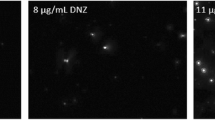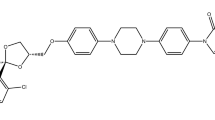ABSTRACT
Purpose
Many enabling formulations give rise to supersaturated solutions wherein the solute possesses higher thermodynamic activity gradients than the solute in a saturated solution. Since flux across a membrane is driven by solute activity rather than concentration, understanding how solute thermodynamic activity varies with solution composition, particularly in the presence of solubilizing additives, is important in the context of passive absorption.
Methods
In this study, a side-by-side diffusion cell was used to evaluate solute flux for solutions of nifedipine and felodipine in the absence and presence of different solubilizing additives at various solute concentrations.
Results
At a given solute concentration above the equilibrium solubility, it was observed that the solubilizing additives could reduce the membrane flux, indicating that the extent of supersaturation can be reduced. However, the flux could be increased back to the same maximum value (which was determined by the concentration where liquid-liquid phase separation (LLPS) occurred) by increasing the total solute concentration. Qualitatively, the shape of the curves of solute flux through membrane as a function of total solute concentration is the same in the absence and presence of solubilizing additives. Quantitatively, however, LLPS occurs at higher solute concentrations in the presence of solubilizing additives. Moreover, the ratios of the LLPS onset concentration and equilibrium solubility vary significantly in the absence and presence of additives.
Conclusions
These findings clearly point out the flaws in using solute concentration in estimating solute activity or supersaturation, and reaffirm the use of flux measurements to understand supersaturated systems. Clear differentiation between solubilization and supersaturation, as well as thorough understanding of their respective impacts on membrane transport kinetics is important for the rational design of enabling formulations for poorly soluble compounds.









Similar content being viewed by others
Abbreviations
- ASD:
-
Amorphous solid dispersion
- BSA:
-
Bovine serum albumin
- CMC:
-
Critical micelle concentration
- FaSSIF:
-
Fasted state simulated intestinal fluid
- GI:
-
Gastrointestinal
- HPMC:
-
Hydroxypropylmethyl cellulose
- LLPS:
-
Liquid-liquid phase separation
- MWCO:
-
Molecular weight cut off
- TFA:
-
Trifluoroacetic acid
- UV:
-
Ultraviolet
REFERENCES
Augustijns P, Brewster ME. Supersaturating drug delivery systems: fast is not necessarily good enough. J Pharm Sci. 2012;101:7–9.
Brouwers J, Brewster ME, Augustijns P. Supersaturating drug delivery systems: the answer to solubility-limited oral bioavailability? J Pharm Sci. 2009;98:2549–72.
Müllertz A, Ogbonna A, Ren S, Rades T. New perspectives on lipid and surfactant based drug delivery systems for oral delivery of poorly soluble drugs. J Pharm Pharmacol. 2010;62:1622–36.
Alonzo D, Zhang GZ, Zhou D, Gao Y, Taylor L. Understanding the behavior of amorphous pharmaceutical systems during dissolution. Pharm Res. 2010;27:608–18.
Alonzo DE, Raina S, Zhou D, Gao Y, Zhang GGZ, Taylor LS. Characterizing the impact of hydroxypropylmethyl cellulose on the growth and nucleation kinetics of felodipine from supersaturated solutions. Cryst Growth Des. 2012;12:1538–47.
Sassene PJ, Knopp MM, Hesselkilde JZ, Koradia V, Larsen A, Rades T, et al. Precipitation of a poorly soluble model drug during in vitro lipolysis: characterization and dissolution of the precipitate. J Pharm Sci. 2010;99:4982–91.
Hsieh Y-L, Ilevbare G, Van Eerdenbrugh B, Box K, Sanchez-Felix M, Taylor L. pH-Induced precipitation behavior of weakly basic compounds: determination of extent and duration of supersaturation using potentiometric titration and correlation to solid state properties. Pharm Res. 2012;29:2738–53.
Corrigan OI, Farvar MA, Higuchi WI. Drug membrane transport enhancement using high energy drug polyvinylpyrrolidone (PVP) co-precipitates. Int J Pharm. 1980;5:229–38.
Davis AF, Hadgraft J. Effect of supersaturation on membrane transport: 1. Hydrocortisone acetate. Int J Pharm. 1991;76:1–8.
Pellett MA, Davis AF, Hadgraft J. Effect of supersaturation on membrane transport: 2. Piroxicam. Int J Pharm. 1994;111:1–6.
Frank KJ, Rosenblatt KM, Westedt U, Hölig P, Rosenberg J, Mägerlein M, et al. Amorphous solid dispersion enhances permeation of poorly soluble ABT-102: true supersaturation vs. apparent solubility enhancement. Int J Pharm. 2012;437:288–93.
Kumprakob U, Kawakami J, Adachi I. Permeation enhancement of ketoprofen using a supersaturated system with antinucleant polymers. Biol Pharm Bull. 2005;28:1684–8.
Santos P, Watkinson AC, Hadgraft J, Lane ME. Enhanced permeation of fentanyl from supersaturated solutions in a model membrane. Int J Pharm. 2011;407:72–7.
Qi S, Roser S, Edler K, Pigliacelli C, Rogerson M, Weuts I, et al. Insights into the role of polymer-surfactant complexes in drug solubilisation/stabilisation during drug release from solid dispersions. Pharm Res. 2013;30:290–302.
Higuchi T. Physical chemical analysis of percutaneous absorption process from creams and ointments. J Soc Cosmet Chem. 1960;11:85–97.
Malik SN, Canaham DH, Gouda MW. Effect of surfactants on absorption through membranes III: effects of dioctyl sodium sulfosuccinate and poloxalene on absorption of a poorly absorbable drug, phenolsulfonphthalein, in rats. J Pharm Sci. 1975;64:987–90.
Doak AK, Wille H, Prusiner SB, Shoichet BK. Colloid formation by drugs in simulated intestinal fluid. J Med Chem. 2010;53:4259–65.
Frenkel YV, Clark AD, Das K, Wang Y-H, Lewi PJ, Janssen PAJ, et al. Concentration and pH dependent aggregation of hydrophobic drug molecules and relevance to oral bioavailability. J Med Chem. 2005;48:1974–83.
Brick MC, Palmer HJ, Whitesides TH. Formation of colloidal dispersions of organic materials in aqueous media by solvent shifting†. Langmuir. 2003;19:6367–80.
Ilevbare GA, Liu H, Pereira J, Edgar KJ, Taylor LS. Influence of additives on the properties of nanodroplets formed in highly supersaturated aqueous solutions of ritonavir. Mol Pharm. 2013;10:3392–403.
Ilevbare GA, Taylor LS. Liquid–liquid phase separation in highly supersaturated aqueous solutions of poorly water-soluble drugs: implications for solubility enhancing formulations. Cryst Growth Des. 2013;13:1497–509.
Kanzer J, Hupfeld S, Vasskog T, Tho I, Hölig P, Mägerlein M, et al. In situ formation of nanoparticles upon dispersion of melt extrudate formulations in aqueous medium assessed by asymmetrical flow field-flow fractionation. J Pharm Biomed Anal. 2010;53:359–65.
Tachibana T, Nakamura A. A methode for preparing an aqueous colloidal dispersion of organic materials by using water-soluble polymers: dispersion ofΒ-carotene by polyvinylpyrrolidone. Kolloid-ZuZPolymere. 1965;203:130–3.
Aisha AFA, Ismail Z, Abu-salah KM, Majid AMSA. Solid dispersions of α-mangostin improve its aqueous solubility through self-assembly of nanomicelles. J Pharm Sci. 2012;101:815–25.
Van Eerdenbrugh B, Alonzo DE, Taylor LS. Influence of particle size on the ultraviolet spectrum of particulate-containing solutions: implications for in-situ concentration monitoring using UV/Vis fiber-optic probes. Pharm Res. 2011;28:1643–52.
Alonzo DE, Gao Y, Zhou D, Mo H, Zhang GG, Taylor LS. Dissolution and precipitation behavior of amorphous solid dispersions. J Pharm Sci. 2011;100:3316–31.
Raina SA, Zhang GGZ, Alonzo DE, Wu J, Zhu D, Catron ND, et al. Enhancements and limits in drug membrane transport using supersaturated solutions of poorly water-soluble drugs. J Pharm Sci. 2014;103:2736–48.
Raghavan SL, Kiepfer B, Davis AF, Kazarian SG, Hadgraft J. Membrane transport of hydrocortisone acetate from supersaturated solutions; the role of polymers. Int J Pharm. 2001;221:95–105.
Ilevbare GA, Liu H, Edgar KJ, Taylor LS. Maintaining supersaturation in aqueous drug solutions: impact of different polymers on induction times. Cryst Growth Des. 2012.
Abbou Oucherif K, Raina S, Taylor LS, Litster JD. Quantitative analysis of the inhibitory effect of HPMC on felodipine crystallization kinetics using population balance modeling. CrystEngComm. 2013;15:2197–205.
Trasi NS, Taylor LS. Effect of additives on crystal growth and nucleation of amorphous flutamide. Cryst Growth Des. 2012.
Raina SA, Alonzo DE, Zhang GGZ, Gao Y, Taylor LS. Impact of polymers on the crystallization and phase transition kinetics of amorphous nifedipine during dissolution in aqueous media. Mol Pharm. 2014;11:3565–76.
Ilevbare GA, Liu H, Edgar KJ, Taylor LS. Understanding polymer properties important for crystal growth inhibition—impact of chemically diverse polymers on solution crystal growth of ritonavir. Cryst Growth Des. 2012.
Ilevbare GA, Liu H, Edgar KJ, Taylor LS. Inhibition of solution crystal growth of ritonavir by cellulose polymers - factors influencing polymer effectiveness. CrystEngComm. 2012;14:6503–14.
Ilevbare GA, Liu H, Edgar KJ, Taylor LS. Impact of polymers on crystal growth rate of structurally diverse compounds from aqueous solution. Mol Pharm. 2013;10:2381–93.
Kestur US, Taylor LS. Role of polymer chemistry in influencing crystal growth rates from amorphous felodipine. CrystEngComm. 2010;12:2390–7.
Baird JA, Van Eerdenbrugh B, Taylor LS. A classification system to assess the crystallization tendency of organic molecules from undercooled melts. J Pharm Sci. 2010;99:3787–806.
Jian W, Romm MV, Edom RW, Miller VP, LaMarr WA, Weng N. Evaluation of a high-throughput online solid phase extraction–tandem mass spectrometry system for in vivo bioanalytical studies. Anal Chem. 2011;83:8259–66.
Nielsen PB, Müllertz A, Norling T, Kristensen HG. The effect of α-tocopherol on the in vitro solubilisation of lipophilic drugs. Int J Pharm. 2001;222:217–24.
Marsac P, Konno H, Taylor LS. A comparison of the physical stability of amorphous felodipine and nifedipine systems. Pharm Res. 2006;23:2306–16.
Murdande SB, Pikal MJ, Shanker RM, Bogner RH. Solubility advantage of amorphous pharmaceuticals: I. A thermodynamic analysis. J Pharm Sci. 2010;99:1254–64.
Cussler EL. Diffusion: mass transfer in fluid systems, Cambridge University Press. 1988.
Yalkowsky SH. Perspective on improving passive human intestinal absorption. J Pharm Sci. 2012;101:3047–50.
Myerson AS. Handbook of industrial crystllization. Woburn: Butterworth-Heinemann; 2002.
Katneni K, Charman SA, Porter CJH. Use of plasma proteins as solubilizing agents in in vitro permeability experiments: correction for unbound drug concentration using the reciprocal permeability approach. J Pharm Sci. 2008;97:209–24.
Mote US, Bhattar SL, Patil SR, Kolekar GB. Interaction between felodipine and bovine serum albumin: fluorescence quenching study. Luminescence. 2010;25:1–8.
Shore PAB, Bernard B, Hogben CA, Adrain M. The gastric secretion of drugs: a pH partition hypothesis. J Pharmacol Exp Ther. 1957;119:361–9.
ACKNOWLEDGMENTS AND DISCLOSURE
We would like to acknowledge AbbVie Inc. for providing research support for this project as well as ‘The Lilly Endowment for the Optimization of Drug Manufacturing’ grant for graduate student financial support.
Purdue University and AbbVie jointly participated in study design, research, data collection, analysis and interpretation of data, writing, reviewing, and approving the publication. Lynne S. Taylor is a professor at Purdue University, David A. Alonzo is an employee at Gilead Sciences, Inc., Donghua Zhu is an employee at Janssen China and Jianwei Wu is an employee of US FDA. They all have no additional conflicts of interest to report. Shweta A. Raina, Geoff G. Z. Zhang, Yi Gao, and Nathaniel D. Catron are employees of AbbVie and may own AbbVie stock.
Author information
Authors and Affiliations
Corresponding authors
Rights and permissions
About this article
Cite this article
Raina, S.A., Zhang, G.G.Z., Alonzo, D.E. et al. Impact of Solubilizing Additives on Supersaturation and Membrane Transport of Drugs. Pharm Res 32, 3350–3364 (2015). https://doi.org/10.1007/s11095-015-1712-4
Received:
Accepted:
Published:
Issue Date:
DOI: https://doi.org/10.1007/s11095-015-1712-4




